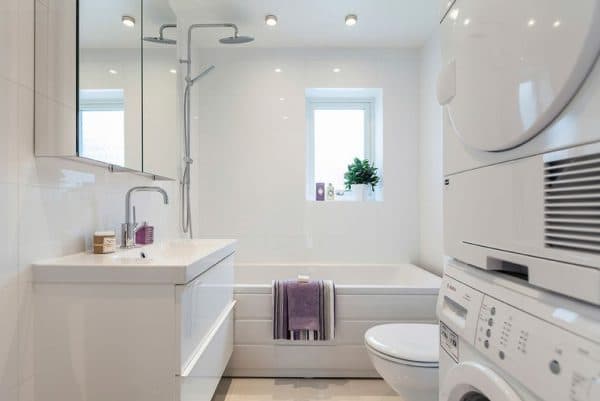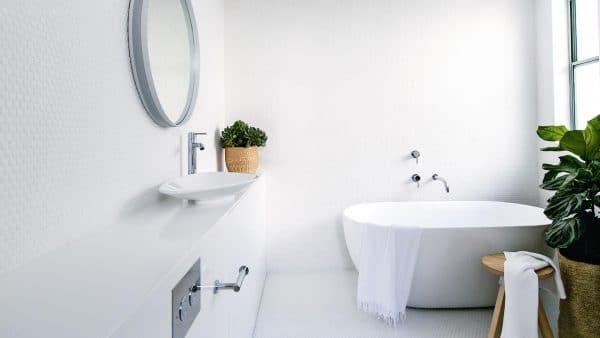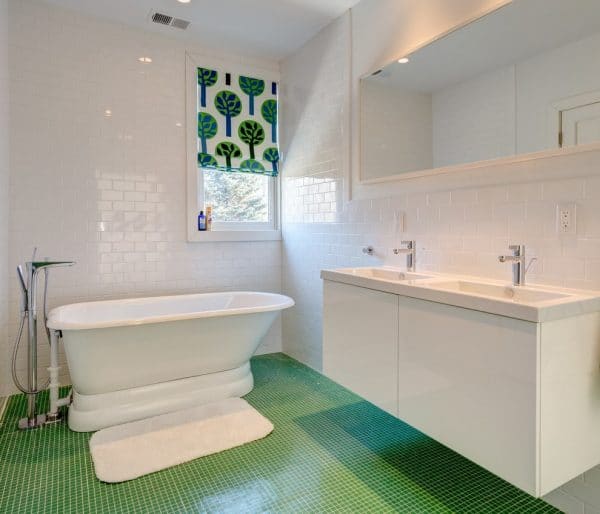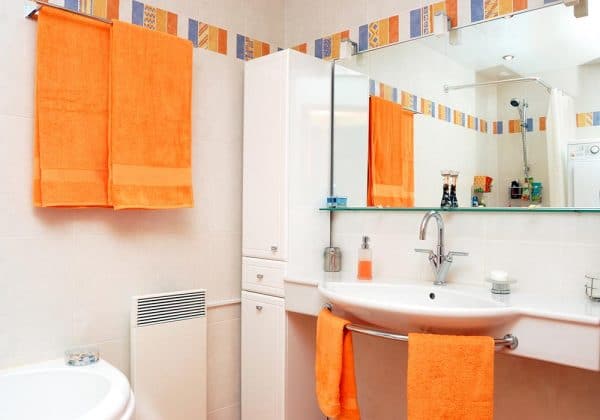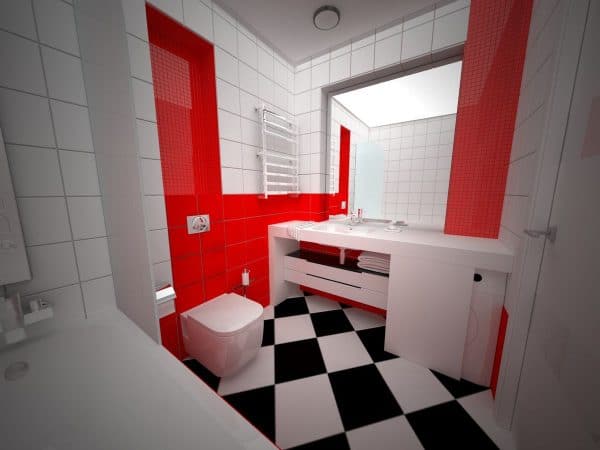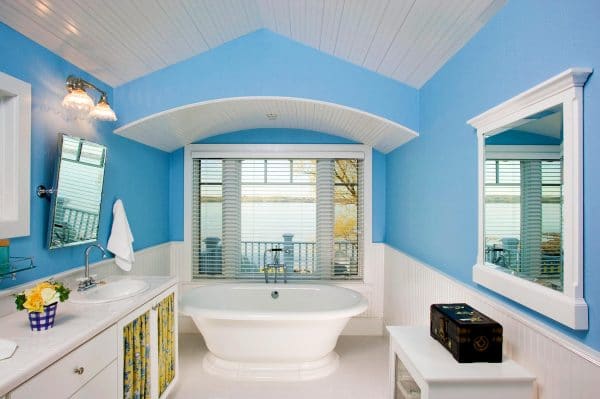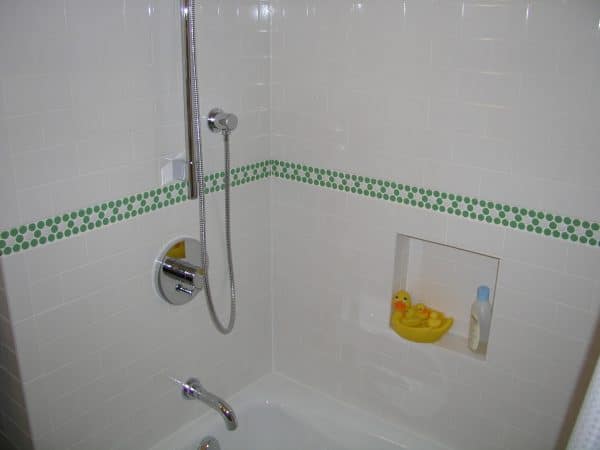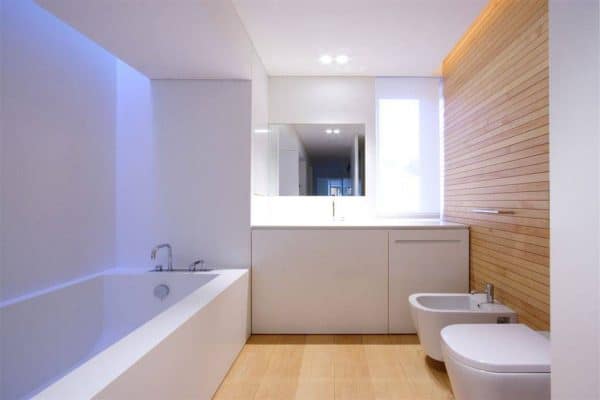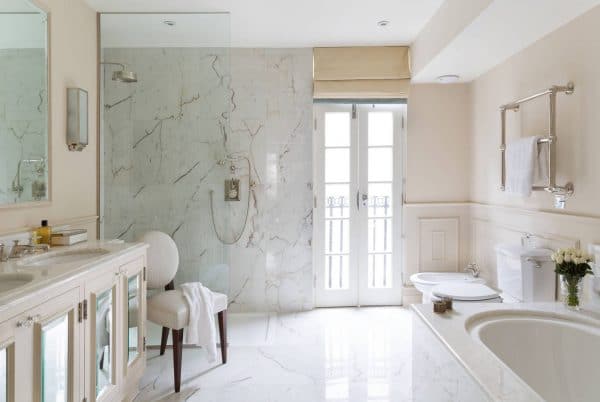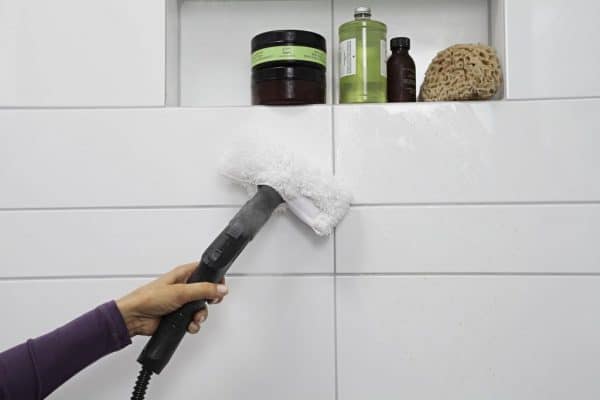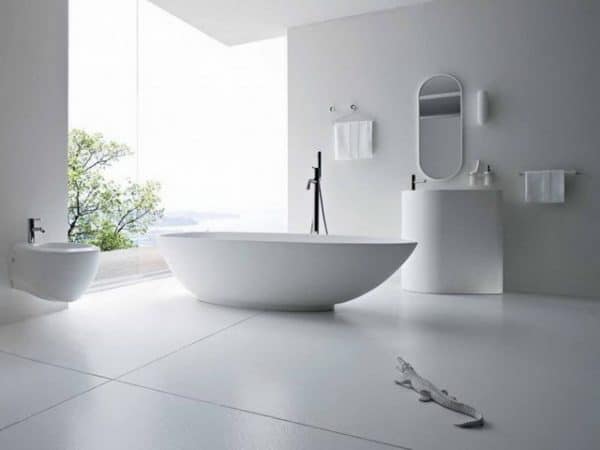During repairs in the bathroom, it is sometimes difficult to choose the optimal shade of the tile. It is especially difficult in a small room, because dark and bright materials can cause an oppressive impression here, besides they quickly get bored.
- The effect of white on humans
- Pros and cons of white in the bathroom
- Combination with other tones.
- Adding color to a white finish
- White and black bathroom option
- White, red and black
- White and warm shades
- White and cool shades
- The choice of materials for a white bathroom
- All shades of white and wood surfaces
- Decorative stone and brick
- Mosaic
- Marble
- Avoiding Negative Associations
- Tiled Care
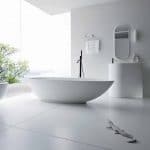
A universal design option is considered a white bathroom. She will become the embodiment of purity, elegance and will appeal to everyone.
The effect of white on humans
Light colors have a unique ability to visually expand the space. For city apartments, this is a rather relevant topic, because bathrooms here are rarely dimensional. White is also suitable for a large apartment or a country house, it helps to smooth out asymmetrically located sections, visually hides unnecessary niches, bevels.
In addition to practical significance, white plays a positive role at the mental level. Having decorated the walls in the bathroom in white, you can be sure that a feeling of freshness, cleanliness will be present in the room daily. This tone is considered a symbol of innocence, high spirituality and even a certain solemnity. It helps to get relaxation and tranquility, for which most of us go to the bathroom in the evening, after a hard day. Psychologists believe that white tones can only generate positive emotions, so they are widely used in interiors.
to contents ↑Pros and cons of white in the bathroom
The advantages of the bathroom in white are obvious. In addition to the fact that this type of decoration visually pushes the walls and raises the ceiling, it seems to add light to the room. White tile, ceramics with gloss - ideal for creating the illusion of spaciousness in the smallest room.
Oddly enough, the white tile in the bathroom is the easiest to clean. On dark and bright surfaces, limescale is more visible, splashes from dried water, and on a white tile they are almost invisible. Moreover, almost all cleaning products, even alkaline, are suitable for ceramic tiles, corners, PVC panels and other white materials.
Other advantages of a white bath are as follows:
- Irregularities in white-trimmed walls are less noticeable. Even paint of this color will visually hide minor flaws, while dark finishes will emphasize them.
- White is a classic color, it will never go out of style, it gives the room a stylish look. This tone is suitable for most interior styles: Scandinavian, modern, Provence, Art Nouveau, minimalism, Empire style. You can even include it in the loft, decorating the wall with small white bricks.
- Snow-white surfaces in the bathroom give it aristocracy, sophistication, they look most elegant. White will never spoil the mood, on the contrary, his radiance will ensure cheerfulness in the morning.
- Only white matches perfectly with all tones of the spectrum.It will dilute black, brown, purple and other dark shades, complement beige, caramel and other pastel colors. White will be a contrast for bright colors (orange, red, green) and emphasize the nobility of precious shades: silver, gold.
Snow-white plumbing - a shower or bathtub, sink, toilet bowl - are considered classics of the genre, they have an infinite number of modifications and will always be in the spotlight. To give the interior originality, it is enough to install plumbing of an unusual shape and design.
to contents ↑There are practically no shortcomings in the white bathroom. Perhaps, with a rare washing, the tiles may fade, become grayish in appearance, but such a thing will never happen with a good housewife. Some people consider a pure white room to be too sterile, but it is not difficult to solve the problem: you need to add interesting furniture, borders, other decor and accessories in a contrasting color.
Combination with other tones.
As already noted, the snow-white color and its other variations are easily combined with all shades of the gamut. For a small bathroom, it is better to make white the main one and introduce another 1-2 shades as additional ones.
Adding color to a white finish
To diversify the design in white colors, you can apply the finish with bright accents. There is an easy way to change the style of the room and make it “juicier" - to introduce colorful accessories:
- shelves;
- floor mats;
- curtains;
- mirrors with bright frames;
- towels;
- decorative elements.
One wall can be finished with a mosaic of a more saturated shade, usually it is used directly at the bathtub. Another interesting trick - to use a beautiful edging for white tiles or to include decorative elements in any order - this will also bring juicy notes to the interior. Dark slatted stripes in the flooring, contrasting color grout for white tiles will also help to decorate the room and dilute the sense of sterility. You can even install dark tiles on the floor - it looks very impressive.
to contents ↑White and black bathroom option
Usually a combination of black and white colors in the bathroom is used in minimalism, modern. Such a pronounced contrast will give the room dynamism, highlight the decor and definitely deprive the interior of boredom. It is important not to use too elaborate forms, the duet of black and white recognizes laconicism, simple lines.
White, red and black
Most often, in this design, white is the main one, red is optional, and black is used accentuated. It is necessary to design the bathroom in red colors with caution, this color is aggressive, therefore, with an excess, it can cause irritation and worsen mood. You can use all three colors on the floor, alternating black and red tiles with white accents, and finish the walls in light colors and add a few red accessories.
to contents ↑White and warm shades
Adding warm colors to the interior is used to enhance the feeling of coziness, home comfort. You can make the bath not white, but ivory, cream, beige, almond, vanilla, or apply other tones that are close to white. Another option is to dilute the snow-white setting with brown, gold, orange, pink, peach, lilac shades. Improving the perception of warm colors will help the use of matte surfaces, as well as yellow light for central lighting, lighting mirrors and wall cabinets.
to contents ↑White and cool shades
Snow white itself looks cold, especially in a glossy finish. But in a large room with a good level of illumination, it may well be complemented by other cool shades. The most popular is the marine style, where white is combined with blue, blue. The latter can be used in accessories: curtains, rugs, cups and coasters.
to contents ↑No less successfully looks green on a snow-white background in the form of patterns, inserts on the walls, veins on marble tiles, as well as in decorative elements, in textiles, which are located on the heated towel rail, and even in living plants.
The choice of materials for a white bathroom
By combining different materials with different surfaces, you can achieve stylish effects in the bathroom. Different materials are used in this room: plastic panels, textured plaster, acrylic and latex paint. Nevertheless, the leader among the finishing coatings remains ceramic tile, which has a huge color palette and allows you to create interesting style solutions. You can choose a tile for a bathroom, taking into account such tips:
- original light coating looks like a brick;
- a large square tile of two colors, laid out in a checkerboard pattern, is used on the floor;
- the white floor with contrasting borders and seams looks elegant;
- An interesting technique in the bathroom is the formation of horizontal and vertical stripes of tiles.
All shades of white and wood surfaces
White color is often called not only snow-white, but also tones close to it: almond and vanilla, milk and ivory, cream and the color of eggshells. These colors are warmer, because they deprive the bathroom of the coldness, severity that snow-white gives it. It is warm shades that are recommended to be combined in the bathroom with wooden surfaces, and the latter will become the center of attraction in any performance.
Dark wood in a pedestal, doors, cabinets, shelves looks especially beautiful against a light background. You can also arrange a storage system under the sink with a tree, make a small decorative or functional shelving, whatnot. An unusual design solution is the lining of the wall or its parts with wooden panels that are pre-treated with special water-repellent impregnations with antifungal additives.
to contents ↑If desired, you can use less expensive materials that mimic wood. The laminate should be moisture resistant, it will serve for a long time and will not be afraid of water. With it, they usually draw up the floor in the bathroom. However, puddles should not be left on the floor for a long time, because they do not benefit the polymer film on the surface of the laminate.
Decorative stone and brick
The use of decorative stone, natural or artificial brick is a fashionable trend in the interior of the bathroom. These materials have a rich color palette, including a variety of light shades. Most often, imitation of brickwork is used in the loft style. You can use the bright colors of stone and brick for contrasting the decoration of white tiles to give the bathroom a residential, cozy look.
Mosaic
Mosaic tiles will be a great alternative to conventional large format tiles. White mosaic can be monophonic or in the form of a panel with drawings, sometimes it combines several shades with overflows. Mosaic decorate one wall in the bathroom or the entire room, creating interesting design options.
Marble
Marble tiles are most often used for flooring. In the bathroom, white marble looks expensive, noble, it is usually used in a classic style in rooms with large dimensions. The marble finish of the sink with a faucet looks no less interesting: this technique is popular in the high-tech style.
to contents ↑Avoiding Negative Associations
Some people in the bathroom may have the feeling of being in the operating room, rather than in a comfortable room, which interferes with getting relaxation, finding peace. In order not to achieve a negative effect during the repair, you must avoid the total white design. You can use one of the design techniques to dilute the snow-white “winter”:
- apply not a pure white color, but a shade close to it with the addition of a yellowish or beige tone;
- include blue, greenish color in the decor and accessories;
- use bright yellow illumination in chandeliers, lamps;
- introduce juicy spots: brown, burgundy, purple, wood accessories;
- apply not only smooth surfaces, but also textured: mosaic, stone, brick, decorative pebble.
to contents ↑
Tiled Care
The tile is a durable, wear-resistant material, but, like any surface, needs regular washing. It is not recommended to use products containing pumice and sand for care. The latter form microscopic cracks on the surface into which dirt accumulates, and the white tile will become grayish in appearance over time.
Glossy tiles should not be rubbed with any abrasive means or hard brushes, it can quickly lose its gloss, and the top coating will begin to collapse. Acidic cleaning agents are also harmful, but not for tiles, but for grouting. Epoxy grouts alone do not respond to the harmful effects of acids. It is also impossible to use kitchen gels, the so-called “grease removers”, for washing: from them the white grout can turn yellow.
It is best to use specialized products for bath care. Matte tiles are washed with emulsions, and after cleaning they are coated with special wax formulations. For work, foam sponges, flannel wipes, microfiber, mohair, brushes with soft bristles should be used. They will help maintain the "life" of the tile for many years and keep it clean and fresh!

